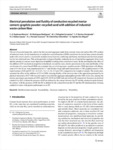

PARTNER
검증된 파트너 제휴사 자료
Electrical percolation and fluidity of conductive recycled mortar cement: graphite powder: recycled sand with addition of industrial waste carbon fiber
14 페이지
최초등록일 2023.05.08
최종저작일
2021.08

-
 * 본 문서는 배포용으로 복사 및 편집이 불가합니다.
* 본 문서는 배포용으로 복사 및 편집이 불가합니다.
미리보기
서지정보
· 발행기관 : 한국탄소학회
· 수록지 정보 : Carbon letters / 31권 / 4호
· 저자명 : C. A. Espinoza‑Moreno, M. Rodriguez‑Rodriguez, M. J. Pellegrini‑Cervantes, C. P. Barrios‑Durstewitz, R. E. Núñez‑Jaquez, H. J. Peinado‑Guevara, M. Chinchillas‑Chinchillas, G. Fajardo‑San‑Miguel
목차
Abstract
1 Introduction
2 Experimental part
2.1 Materials
2.2 Methods
3 Results and discussion
3.1 Properties of the materials
3.2 Fluidity and electric percolation of CRM
4 Conclusions
References영어초록
The use of recycled materials, such as the fine recycled aggregate made from concrete waste and carbon fiber (CF) product of industrial waste, for the manufacture of conductive recycled mortars (CRM), transforms the mortar base cement normally made with cement:sand in a sustainable multifunctional material, conferring satisfactory mechanical and electrical properties for non-structural uses. This action provides ecological benefits, reducing the use of natural fine aggregates from rivers and the amount of concrete waste deposited in landfills resulting from construction waste. In this investigation the effect of the addition of CF on electrical properties in hardened, wet and dry state, electric percolation in dry state and fluidity of the wet mixture of a cement based CRM was evaluated: fine recycled aggregate: graphite powder, CRM specimens with dimensions of 4 × 4 × 16 cm. were manufactured for 3, 7 and 28 days of age and sand/cement ratios = 1.00, graphite/cement = 1.00, water/cement = 0.60 and CF = 0.1, 0.3, 0.5, 1.0, 1.5, 2.0, 2.5 and 3.0% compared to the weight of cement. The results demonstrated the effect of the addition of CF in CRM, reducing fluidity of the mixtures due to the opposition generated by its physical interaction of CF with recycled sand or recycled fine aggregate and graphite powder (GP), in its case, placing the electric percolation percolation at 0.30% and 0.45% of CF for CRM with and without GP, respectively. Increases in electrical conductivity (EC) without the presence of GP are defined by the contact between the CF and the conductive paths formed. In contrast, with the presence of GP, the EC is defined by the contact between the CF and the GP simultaneously, forming conductive routes with greater performance in its EC.참고자료
· 없음태그
-
자료후기
-
자주묻는질문의 답변을 확인해 주세요

꼭 알아주세요
-
본 학술논문은 (주)코리아스칼라와 각 학회간에 저작권계약이 체결된 것으로 AgentSoft가 제공 하고 있습니다.
본 저작물을 불법적으로 이용시는 법적인 제재가 가해질 수 있습니다. -
해피캠퍼스는 구매자와 판매자 모두가 만족하는 서비스가 되도록 노력하고 있으며, 아래의 4가지 자료환불 조건을 꼭 확인해주시기 바랍니다.
파일오류 중복자료 저작권 없음 설명과 실제 내용 불일치 파일의 다운로드가 제대로 되지 않거나 파일형식에 맞는 프로그램으로 정상 작동하지 않는 경우 다른 자료와 70% 이상 내용이 일치하는 경우 (중복임을 확인할 수 있는 근거 필요함) 인터넷의 다른 사이트, 연구기관, 학교, 서적 등의 자료를 도용한 경우 자료의 설명과 실제 자료의 내용이 일치하지 않는 경우
“Carbon letters”의 다른 논문도 확인해 보세요!
-
Synthesis of MoS2 nanoparticles grown on crumpled 3D graphene microbal.. 6 페이지
-
Development of nitrogen‑doped carbon quantum dots as fluorescent probe.. 9 페이지
-
Facile tuning of carbon nanotube morphologies via residual carbon cont.. 11 페이지
-
Modification of the graphene oxide surface with copper pentacyanonitro.. 13 페이지
-
Activated carbon microspheres derived from hydrothermally treated mang.. 15 페이지
문서 초안을 생성해주는 EasyAI

